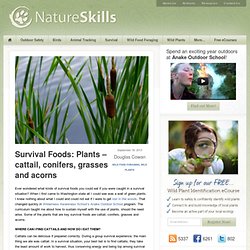

Forgotten Plants. Survival Foods: Cattail, Conifers, Grasses & Acorns. Ever wondered what kinds of survival foods you could eat if you were caught in a survival situation?

When I first came to Washington state all I could see was a wall of green plants. I knew nothing about what I could and could not eat if I were to get lost in the woods. That changed quickly in Wilderness Awareness School’s Anake Outdoor School program. The curriculum taught me about how to sustain myself with the use of plants, should the need arise. Some of the plants that are key survival foods are cattail, conifers, grasses and acorns. Where Can I Find Cattails and How Do I Eat Them? Cattails can be delicious if prepared correctly. Cattail does have a look-alike, the iris. Cattails are almost always in or next to a water source.
Young shoots are the tastiest part of the plant. Munching From Conifers Did you know that many types of conifer trees are edible? Survival Foods: The Grass Family More than 400 types of grasses can be eaten worldwide. Gathering Acorns Sources: The Fantastic Four – 4 Essential Wild Edible Plants that May Just Save Your Life. Did you realize that knowing just 4 wild edible plants could one day save your life?

If there were any four categories of plants that I would recommend all people to know how to use and identify it would be these: Grass, Oak, Pine, and Cattail. For the knowledgeable survivor, knowing just these four plants can make the difference between life and death if stranded in the wilds – for each one is an excellent food source which can sustain you until help arrives. Throughout this week and part of the next, I’ll be going into details on how you can prepare and eat these plants. For now though, here’s a quick overview into what they have to offer: Grass Surprising to many is the fact that you can eat grass. The young shoots up to 6 inches tall can be eaten raw and the starchy base (usually white and at the bottom when you pluck it) can be eaten as a trail nibble. Oak Oak – specifically the acorn – is a great source of food in the fall and early winter time. Pine “You can eat pine?!”
Cattail. How To Eat Wild Foods & Not Get Poisoned (How-To) Let's play pretend for a moment.

Are you with me? Let's pretend you can't go down to the supermarket for food to eat. In fact, let's pretend that there is not a supermarket for one hundred miles in any direction, and you don't have any food with you. In this pretend land, you are stranded in the wilderness. Perhaps your GPS navigation unit directed you to detour onto a closed mining road in the middle of nowhere, and you didn't have the sense to second-guess it until your rental car got stuck in seasonal mud, and you decide to head out into the woods instead of following the road back.